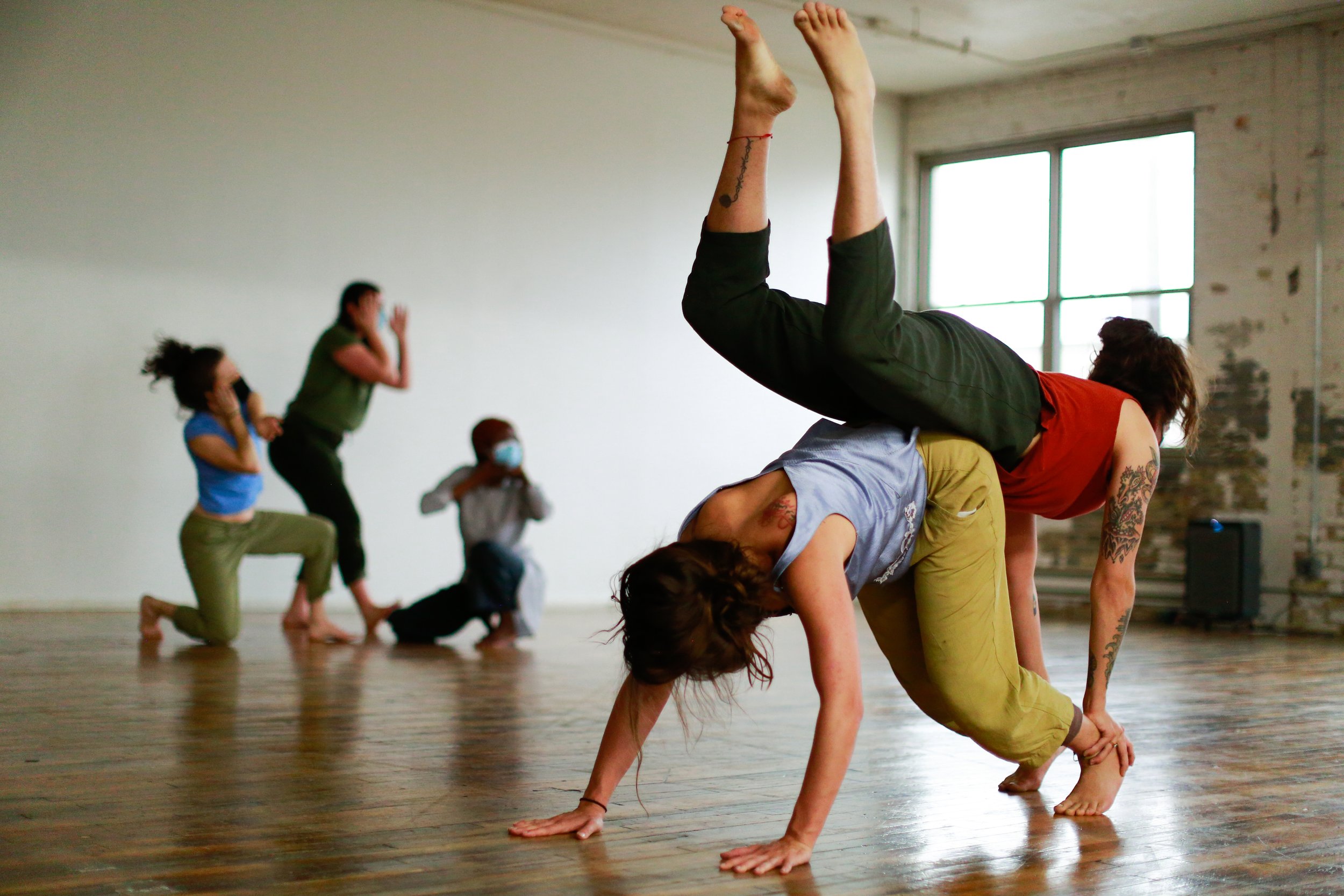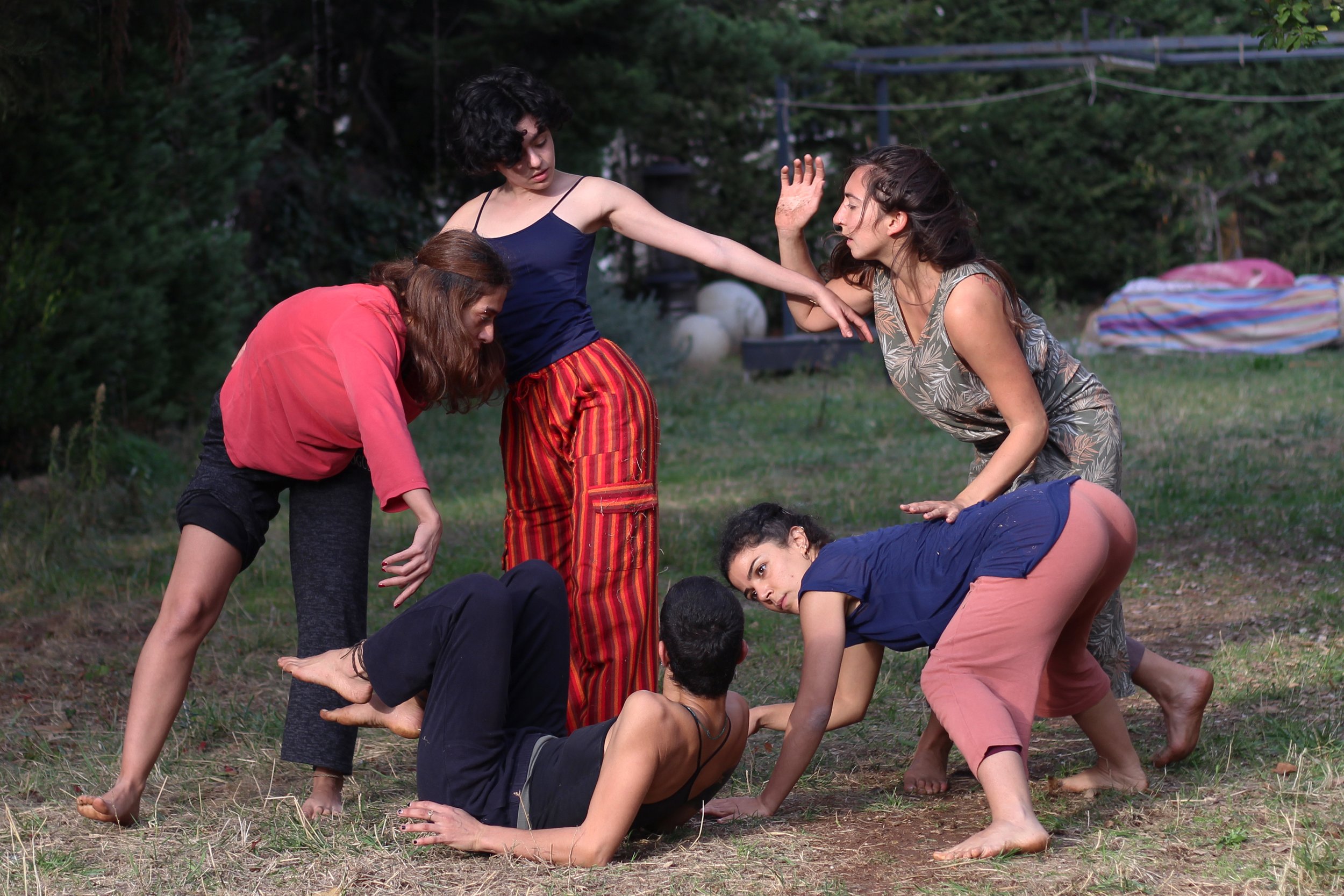About
Body Watani - Minneapolis, Mni Sota Makoce collective
Erica Jo Vibar Sherwood, Nakita Kirchner, Sharitah Nalule, Leila Awadallah, Noelle Awadallah, Emma Marlar (not pictured)
Image by Erica Ticknor
Body Watani is both an improvisational movement practice and an emerging contemporary dance form developed by Leila Awadallah in blossoming collaboration with her sister Noelle Awadallah, two Palestinian American dancers (watani translates to homeland in Arabic). THE PRACTICE is a container with soft edges where improvisational research guides practitioners into their personal ‘body watani’, or body-as-homeland through spending time with ancestries, contemplating our complex relations to land / water / home, and activating embodied memories into one's own dancing. Body Watani also manifests as a contemporary form with roots in dances of Arabic / SWANA / Mediterranean lands through specific movement techniques, music of the region, and cultural / political content to engage with that deepens our relation to Body Watani’s context; birthed from diasporic Palestinian daughters of a land under occupation.
Body Watani - Beirut, Lebanon collective
Sarah Almoneem, Natasha Karam, Layal Berberi, Stephanie Estephan, Leila Awadallah, (not pictured): Zaynab Mourad, and Romy Lynn Attieh.
Image by Zaynab Mourad
THE PROJECT, or collective, is made up of a group of dancers in Minneapolis, Mni Sota and another group of dancers in Beirut, Lebanon. Both collectives practice and rehearse in seasons with Leila Awadallah, deepening the inquiries and rituals of the practice while also simultaneously developing two versions of the piece: TERRANEA hakawati of the sea which premiered as an excerpt as Featured Artists at Candy Box Festival - Minnesota, May 2022. Later that year, it premiered in full with the Lebanon cast at Hammana Artist House - Nov. 2022, followed by a performance at the Al Madina Theatre. In spring of 2023, the Turtle Island premiere of the full length piece with the MN cast took place at Red Eye Theater (April 2023) followed by a tour to the Arab American National Museum (Dearborn MI) and Links Hall (Chicago, IL).
MINNEAPOLIS:
LEILA AWADALLAH, NOELLE AWADALLAH, NAKITA KIRCHNER, EMMA MARLAR, SHARITAH NALULE, ERICA JO VIBAR SHERWOOD
BEIRUT:
ANDREA FAHED, NATASHA KARAM, with support from ZAYNAB MOURAD
With thanks to those who were involved in the process: Sarah Almoneem, Romy Lynn Attieh, Layal Berberi, Stephanie Estephan
Residency at Hammana Artist House; footage by Xiaolu Wang
We began building this practice specifically for peoples whose relationship to ‘home’ is charged, messy, and complex. Where researching movement-making that is rooted in ancestral bodily memories ranging from personal, to collective, to those of our non-human relatives. Like an archeologist who digs to extract artifacts of ‘truth’ from the past, Body Watani uses durational improvisation and reflective questions to dig into our bodies as dense historical archives, not to extract, but rather to know where nurture and poison live. One of the main elements of Body Watani is that notions of 'home' live inside us. Instead of home being represented by a geographic location or structure, or a DNA test, or anything measurable in Western standards, Body Watani imagines home as memories of lineage and place as a living presence engraved inside our bodies. When dancing within a ‘body as homeland’ framework, one enters a movement investigation centered around a physical, visceral engagement with land and the complexities of what remains of our grandmother’s grandmother’s grandmother.
On Body Watani’s lineage: a note from Leila
Body Watani (BW) as an improvisation practice, research method, and dance form emerges from many experiences and multiple roots and lineages which I would like to make visible. I could write many more, but this is what feels important to say in this moment. As adrienne maree brown writes, “lineage is important to name and impossible to trace”.
I spent 6 years training in Yorchha (Contemporary Indian Dance; Odissi, Chauu, and Yoga), and studying the techniques and philosophies of Ananya Dance Theatre as a performer. My time with the mentorship of Ananya Chatterjea and the ADT artists initiated questions that still reverberate in the core of BW's work, especially in the realm of investigating ‘contemporary’ dance, committing to social justice, and centering BIPOC femme / women communities.
Ongoing conversations and collaborations around the notion of home with the Theatre of the Women of the Camp, based in Borj el Barajneh (Palestinian refugee camp of Lebanon) are embedded and alive in BW’s continuous grappling with ‘body as home’. Stories, songs, struggles, resistance, longing, and erasures all slip into this work from a Palestinian-outside-of-Palestine perspective.
Dialogue around reconfiguring cultures of care within dance spaces (class, rehearsal, etc) with the SLO Practice / Laura Osterhaus continue to call on BW to be intentional in the work of building a practice to share with others. As well as a 5 year improvisation practice in making scores and performing with the Kelvin Wailey dance trio (Laura Osterhaus, Emma Marlar and myself) which is inherent to BW's commitments to improvisation.
Contaminations of proximity and intimate engagement with the following artists: The experimental dances and performances of Leyya Tawil / Lime Rickey. The ways Alexandre Paulikevitch works with the form of Baladi dance. Naima Yazbek, who has given me my most intensive trainings in Raqs Sharqi in Beirut. As well as the untraceable, untrackable learnings that saturate ones’ body when immersed in social dance, live music, and community spaces (Lebanon & Palestine).
Writers such as: adrienne maree brown, Alexis Pauline Gumbs, and Resmaa Menakem who shape so much of this practice with their words.
And of course, the ongoing impact that my sister Noelle Awadallah is bringing into BW’s work along with each dancer who engages deeply in our practice.
And many many many more honoring of thinkers, writers, activists, healers to be named…. Body Watani is not a new invention. It is simply the sacred act of giving something a name so that it can grow beyond me, and become yours, and become ours, to share and interpret, change, bend, fold, unravel, remake, and grow.

